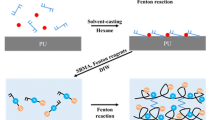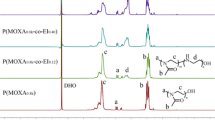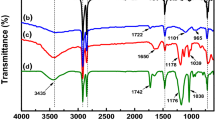Abstract
Surface modified with so-called protein-repellent or antifouling polymers has become indispensable for the development of modern therapeutic and diagnostic medical devices. In this work, a series of novel well-defined poly(2-methyl-2-oxazoline)-block-poly(4-vinyl pyridine) (PMOXA-b-P4VP) diblock copolymers were synthesized by using copper-catalyzed azide-alkyne cycloaddition reaction of α-alkynyl-PMOXA and ω-N3-P4VP, in which α-alkynyl-PMOXA and ω-N3-P4VP were prepared by cationic ring opening polymerization and atom transfer radical polymerization, respectively. Stable coatings were formed when dropping PAA solution on the top of PMOXA-b-P4VP pre-coatings, due to hydrogen-bonding interaction between P4VP and poly(acrylic acid) (PAA). The long-term stability of these PMOXA-b-P4VP/PAA coatings showed that increasing PMOXA chain length can improve not only the hydrophilicity but also the stability of the coatings. This simple method can form stable coatings on either inorganic (such as, silicon wafer and coverslip) or organic material [such as, poly(methyl methacrylate) sheet] surface. At the same time, for the high-hydratability of PMOXA chains, these crosslinked coatings showed well protein-resistant and platelet/cell-repellent properties, and the antifouling properties and long-term availability were enhanced increasing PMOXA polymerization degree.












Similar content being viewed by others
References
Wen XW, Pei SP, Li H, Ai F, Chen H, Li KY, Wang Q, Zhang YM (2010) Study on an antifouling and blood compatible poly(ethylene-vinyl acetate) material with fluorinated surface structure. J Mater Sci 45:2788–2797. doi:10.1007/s10853-010-4268-z
Rahaman MS, Thérien-Aubin H, Ben-Sasson M, Ober CK, Nielsen M, Elimelech M (2014) Control of biofouling on reverse osmosis polyamide membranes modified with biocidal nanoparticles and antifouling polymer brushes. J Mater Chem B 2:1724–1732
Branda F, Costantini A, Laudisio G, Buri A, Ambrosio L (1999) Hydroxyapatite coating of poly(2-hydroxyethyl methacrylate) hydrogel by biomimetic method. J Mater Sci 34:1319–1322. doi:10.1023/A:1004550131705
Luo YL, Zhang CH, Xu F, Chen YH, Fan LH, Wei QB (2010) Synthesis and characterization of novel THTPBA/PEG-derived polyurethane scaffolds for tissue engineering. J Mater Sci 45:1866–1877. doi:10.1007/s10853-009-4171-7
Gudipati CS, Finlay JA, Callow JA, Callow ME, Wooley KL (2005) The antifouling and fouling-release perfomance of hyperbranched fluoropolymer (HBFP)-poly(ethylene glycol) (PEG) composite coatings evaluated by adsorption of biomacromolecules and the green fouling Alga Ulva. Langmuir 21:3044–3053
Roosjen A, de Vries J, van der Mei HC, Norde W, Busscher HJ (2005) Stability and effectiveness against bacterial adhesion of poly(ethylene oxide) coatings in biological fluids. J Biomed Mater Res B 73B:347–354
Shen MC, Martinson L, Wagner MS, Castner DG, Ratner BD, Horbett TA (2002) PEO-like plasma polymerized tetraglyme surface interactions with leukocytes and proteins: in vitro and in vivo studies. J Biomat Sci Polym E 13:367–390
Tauhardt L, Kempe K, Gottschaldt M, Schubert US (2013) Poly(2-oxazoline) functionalized surfaces: from modification to application. Chem Soc Rev 42:7998–8011
Guillerm B, Darcos V, Lapinte V, Monge S, Coudane J, Robin JJ (2012) Synthesis and evaluation of triazole-linked poly(ε-caprolactone)-graft-poly(2-methyl-2-oxazoline) copolymers as potential drug carriers. Chem Commun 48:2879–2881
Hartlieb M, Kempe K, Schubert US (2015) Covalently cross-linked poly(2-oxazoline) materials for biomedical applications—from hydrogels to self-assembled and templated structures. J Mater Chem B 3:526–538
Maechling-Strasser C, Déjardin P, Galin JC, Schmitt A, Housse-Ferrari V, Sébille B, Mulvihill JN, Cazenave JP (1989) Synthesis and adsorption of a poly(n-acetylethyleneimine)-polyethyleneoxide-poly(n-acetylethyleneimine) triblock-copolymer at a silica/solution interface: influence of its preadsorption on platelet adhesion and fibrinogen adsorption. J Biomed Mater Res 23:1395–1410
Yoshinaga K, Hidaka Y (1994) Cationic graft-polymerization of 2-methyl-2-oxazoline on monodispersed polymer-coated ultrafine silica particles. Polym J 26:1070–1079
Xiang LN, Chen LJ, Tan L, Zhang C, Cao FH, Liu ST, Wang YM (2013) The preparation of a novel polydopamine-graft-poly(2-methyl-2-oxazoline)protein-resistant coating and its applications in protein separation. Chin Chem Lett 24:597–600
Zheng XJ, Zhang C, Bai LC, Liu ST, Tan L, Wang YM (2015) Antifouling property of monothiol-terminated bottle-brush poly(methylacrylic acid)-graft-poly(2-methyl-2-oxazoline) copolymer on gold surfaces. J Mater Chem B 3:1921–1930
Bai LC, Tan L, Chen LJ, Liu ST, Wang YM (2014) Preparation and characterizations of poly(2-methyl-2-oxazoline) based antifouling coating by thermally induced immobilization. J Mater Chem B 2:7785–7794
Alexis C, Charnay C, Lapinte V, Robin JJ (2013) Hydrophilization by coating of silylated polyoxazoline using sol-gel process. Prog Org Coat 76:519–524
Konradi R, Pidhatika B, Mühlebach A, Textor M (2008) Poly-2-methyl-2-oxazoline: a peptide-like polymer for protein-repellent surfaces. Langmuir 24:613–616
Pidhatika B, Rodenstein M, Chen Y, Rakhmatullina E, Mühlebach A, Acikgöz C, Textor M, Konradi R (2012) Comparative stability studies of poly(2-methyl-2-oxazoline) and poly(ethylene glycol) brush coatings. Biointerphases 7:1
Konradi R, Acikgoz C, Textor M (2012) Polyoxazolines for nonfouling surface coatings—a direct comparison to the gold standard PEG. Macromol Rapid Commun 33:1663–1676
Liu H, Shi RH, Wan WM, Yang RM, Wang YM (2008) A well-defined diblock copolymer of poly(ethylene oxide)-block-poly(4-vinylpyridine) for separation of basic proteins by capillary zone electrophoresis. Electrophoresis 29:2812–2819
Wang LY, Wang ZQ, Zhang X, Shen JC, Chi LF, Fuchs H (1997) A new approach for the fabrication of an alternating multilayer film of poly(4-vinylpyridine) and poly(acrylic acid) based on hydrogen bonding. Macromol Rapid Commun 18:509–514
Cho JH, Caruso F (2003) Polymeric multilayer films comprising deconstructible hydrogen-bonded stacks confined between electrostatically assembled layers. Macromolecules 36:2845–2851
Tian Y, He Q, Cui Y, Tao C, Li JB (2006) Assembly of nanotubes of poly(4-vinylpyridine) and poly(acrylic acid) through hydrogen bonding. Chem Eur J 12:4808–4812
Ayres N, Cyrus CD, Brittain WJ (2007) Stimuli-responsive surfaces using polyampholyte polymer brushes prepared via atom transfer radical polymerization. Langmuir 23:3744–3749
Zhang WQ, Shi LQ, Gao LC, An YL, Li GY, Wu K, Liu Z (2005) Comicellization of poly(ethylene glycol)-block-poly(acrylic acid) and poly(4-vinylpyridine) in ethanol. Macromolecules 38:899–903
Zhang WQ, Shi LQ, An YL, Wu K, Gao LC, Liu Z, Ma RJ, Meng QB, Zhao CJ, He BL (2004) Adsorption of poly(4-vinyl pyridine) unimers into polystyrene-block-poly(acrylic acid) micelles in ethanol due to hydrogen bonding. Macromolecules 37:2924–2929
Benesch J, Hungerford G, Suhling K, Tregidgo C, Mano JF, Reis RL (2007) Fluorescence probe techniques to monitor protein adsorption-induced conformation changes on biodegradable polymers. J Colloid Interf Sci 312:193–200
Dai ZW, Wan LS, Xu ZK (2008) Surface glycosylation of polyacrylonitrile ultrafiltration membrane to improve its anti-fouling performance. J Membrane Sci 325:479–485
Guillerm B, Monge S, Lapinte V, Robin JJ (2013) Well-defined poly(oxazoline)-b-poly(acrylate) amphiphilic copolymers: from synthesis by polymer-polymer coupling to self-organization in water. J Polym Sci A 51:1118–1128
Kwon IC, Bae YH, Kim SW (1991) Electrically credible polymer gel for controlled release of drugs. Nature 354:291–293
Weber C, Remzi Becer C, Guenther W, Hoogenboom R, Schubert US (2010) Dual responsive methacrylic acid and oligo(2-ethyl-2-oxazoline) containing graft copolymers. Macromolecules 43:160–167
Xu YL, Shi LQ, Ma RJ, Zhang WQ, An YQ, Zhu XX (2007) Synthesis and micellization of thermo- and pH-responsive block copolymer of poly(N-isopropylacrylamide)-block-poly(4-vinylpyridine). Polymer 48:1711–1717
Lee DH, Condrate RA Sr, Reed JS (1996) Infrared spectral investigation of polyacrylate adsorption on alumina. J Mater Sci 31:471–478. doi:10.1007/BF01139166
Vroman L, Adams AL (1969) Identification of rapid changes at plasma-solid interfaces. J Biomed Mater Res 3:43–67
Williams DF (1987) Tissue-biomaterial interactions. J Mater Sci 22:3421–3445. doi:10.1007/BF01161439
Alibeik S, Zhu SP, Yau JW, Weitz JI, Brash JL (2011) Surface modification with polyethylene glycol-corn trypsin inhibitor conjugate to inhibit the contact factor pathway on blood-contacting surfaces. Acta Biomater 7:4177–4186
Wei HL, Han LL, Tang YC, Ren J, Zhao ZB, Jia LY (2015) Highly flexible heparin-modified chitosan/graphene oxide hybrid hydrogel as a super bilirubin adsorbent with excellent hemocompatibility. J Mater Chem B 3:1646–1654
Liu XL, Yuan L, Li D, Tang ZC, Wang YW, Chen GJ, Chen H, Brash JL (2014) Blood compatible materials: state of the art. J Mater Chem B 2:5718–5738
Chen SF, Li LY, Zhao C, Zheng J (2010) Surface hydration: principles and applications toward low-fouling/nonfouling biomaterials. Polymer 51:5283–5293
Rahimpour A, Madaeni SS (2007) Polyethersulfone (PES)/cellulose acetate phthalate (CAP) blend ultrafiltration membranes: preparation, morphology, performance and antifouling properties. J Membrane Sci 305:299–312
Chen NC, Chen YW, Wang LJ, Luo XL, Luo J, Wang B (2009) Preparation, characterization, and blood compatibility of polylactide-based phospholipid polymer. J Mater Sci 44:6317–6324. doi:10.1007/s10853-009-3870-4
Ai F, Li H, Wang Q, Yuan WZ, Chen XY, Yang LB, Zhao JH, Zhang YM (2012) Surface characteristics and blood compatibility of PVDF/PMMA membranes. J Mater Sci 47:5030–5040. doi:10.1007/s10853-012-6379-1
Howell D, Behrends B (2006) A review of surface roughness in antifouling coatings illustrating the importance of cutoff length. Biofouling 22:401–410
Acknowledgements
Special thanks to Prof. Longping Wen for kindly supplying us with human umbilical vein endothelial cells. This work was supported by the National Natural Science Foundation of China (Grant No. 21374109) and the Ministry of Science and Technology of China (Grant No. 2012CB933802).
Conflict of interest
The authors have declared no conflict of interest.
Author information
Authors and Affiliations
Corresponding author
Electronic supplementary material
Below is the link to the electronic supplementary material.
Rights and permissions
About this article
Cite this article
Tan, L., Bai, L., Zhu, H. et al. Stable antifouling coatings by hydrogen-bonding interaction between poly(2-methyl-2-oxazoline)-block-poly(4-vinyl pyridine) and poly(acrylic acid). J Mater Sci 50, 4898–4913 (2015). https://doi.org/10.1007/s10853-015-9035-8
Received:
Accepted:
Published:
Issue Date:
DOI: https://doi.org/10.1007/s10853-015-9035-8




